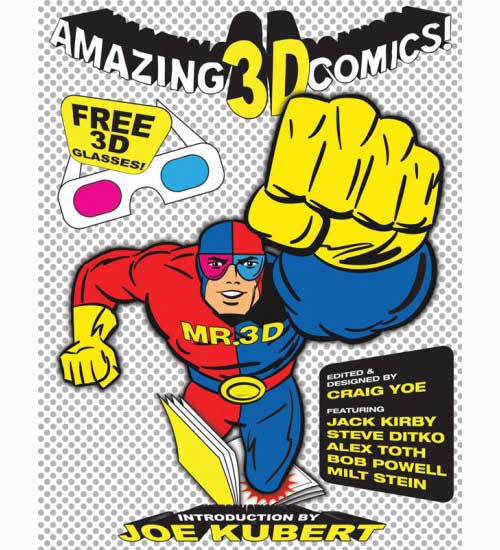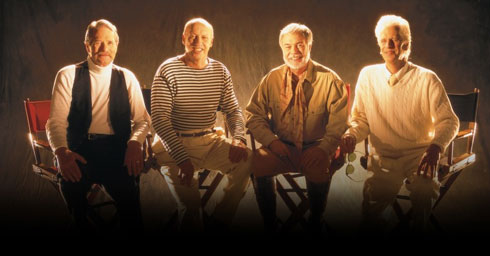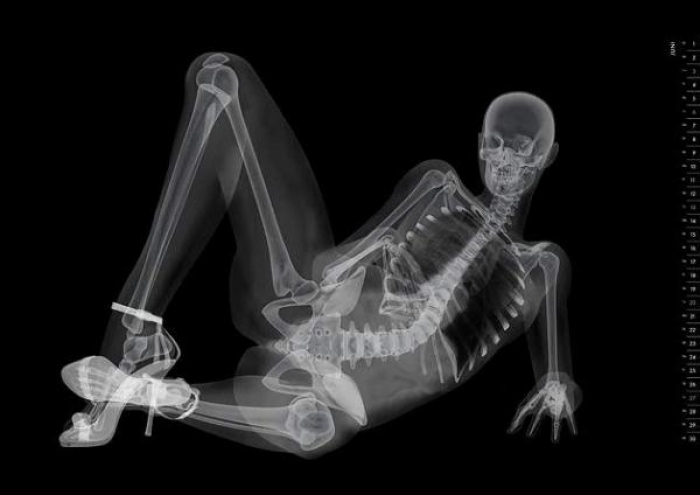“Amazing 3D Comics” – Best of 1950’s 3D Comic Books edited by Craig Yoe
November 12, 2010
Oh, yeah – this is gonna be sweet! Eisner Award winner comics expert and designer Craig Yoe collects the best of 1950s 3D comics by such legendary talents as Jack Kirby, Steve Ditko, Alex Toth, Russ Heath, Al Jaffee, Bob Powell, Milt Stein and puts them between hard covers.
Re-mastered and restored, these works represent every genre: superhero, jungle adventures, horror comics, science fiction, funny animals, satire, western and romance! With a behind-the-scenes introduction by the mastermind behind 3D comics himself, Joe Kubert. Includes rare art and ephemera and a 3D lenticular cover.
Publication date: Feb. 1, 2011. Available for pre-order now from all the usual sources.
Classic Firesign Theatre Live Radio Shows Streaming on WFMU
November 11, 2010
For the uninitiated, the Firesign Theatre – Philip Austin, Peter Bergman, David Ossman and Philip Proctor – is a comedy group that began on the radio in 1966 and remains together to this day (after several break-ups and re-groupings) producing their unique blend of surreal and silly audio delights.
Now, like worms out of hot cheese log, WFMU 91.1 FM in NYC, is rebroadcasting 16 hours of the Firesign’s work from 1970-1972, re-mixed and re-mastered for your edutainment and delight at http://wfmu.org/playlists/FT.
Even more exciting is the news that a reissue package of the Firesign Theatre’s complete broadcast history from 1970-1972 is being prepared for release. Gimme two! Sorry, only Tub per family. That’s Whole Beef Halves–We Deliver. Everywhere. Offer not good after curfew in sectors R and N.
The Firesign Theatre’s ‘classic’ period is judged by most to be 1968 to 1974 during which they released 8 LP albums on the Columbia Records label (on vinyl for you youngsters, see list below). They also appeared on four radio programs, Radio Free Oz, the Firesign Theatre Radio Hour Hour, Dear Friends and Let’s Eat. At their best the result of their collaboration results in a densely layered audio ‘movie’ both topical and self-referential, laced with pointed satire and a high order of wordplay.
For ‘A Not-So-Brief History’ of the group through 2002 see Frederick C. Wiebel, Jr.’s piece here.
Most of their commercially released material has been re-issued on CD’s, some is available for digital download on iTunes. But obtaining copies of their live radio work has long been the ‘holy grail’ for devoted Fireheads. It was from their improvised, free form radio work – incorporating found texts, short scripts and random music and sound effects – that many of their themes and albums developed.
So fellow kids, let’s give thanks to WFMU and everyone involved in reviving and re-broadcasting these classic FST radio programs.
Waiting for the Electrician or Someone Like Him January 1968
How Can You Be in Two Places at Once When You’re Not Anywhere at All July 1969
Don’t Crush That Dwarf, Hand Me the Pliers July 1970
I Think We’re All Bozos on This Bus 1971
Dear Friends January 1972
Not Insane or Anything You Want To October 1972
The Tale of the Giant Rat of Sumatra January 1974
Everything You Know Is Wrong October 1974
X-Ray Pin Ups? Actually, Digital Creations for EIZO Monitors Promotion
November 3, 2010
You may have seen these around the web recently and thought they were real X-Rays of pin-up models, something like the fantastic work of Nick Veasey. But they are actually completely digital creations by CGI Illustrator Carsten Mainz of the German advertising agency Butter for their client EIZO monitors. Check out the WIRED piece for a complete explanation, here. Click images for larger size.
Salvation for Michael Vick’s Dogs – “The Lost Dogs” by Jim Gorant
November 3, 2010

I’ve written before about the dogs of Bad Newz Kennels run by Michael Vick and must draw your attention to the excellent new book by Jim Gorant, The Lost Dogs: Michael Vick’s Dogs and their Tale of Rescue and Redemption. Gorant is the reporter who wrote the Sports Illustrated cover story (December 29, 2008) about this case and so was ideally positioned to do the extensive follow up in this book. That cover story generated more letters and emails than any other SI story that year, a measure of the outrage and controversy surrounding this case. A very few saw the attention paid here as disproportionate, or in the extreme, racist. I find it hard to sympathize with those views.
Of course, when a third of the world goes to bed hungry at night you can make the case that the sympathy and attention these dogs received is the luxury of the haves as opposed to the have-nots. Our indifference to human suffering can be appalling, but the fact that we cannot solve every problem should not prevent us from tackling the ones we can solve. And it’s hard not to see these pit bull and pit bull mixes as the unwilling, unfortunate victims of a callous blood sport.
That football itself is a brutal, violent game that generously rewarded Michael Vick for his skill says something else about what we value in our culture. But, as far as I’m aware, we don’t electrocute, hang, drown or shoot unsuccessful NFL players. (We do permit some of them to suffer massive head traumas that leave them with cognitive problems like memory loss, confusion, speech impediments, early onset Alzheimer’s, nausea, depression, blurred vision, headaches, the inability to concentrate and other neurological problems. However, 1.) Your average NFL player is not nearly as cute an adorable as your average American Staffordshire Terrier and 2.) They make a choice about their profession that pit bulls clearly do not).
The uplifting part of this story is that of 51 dogs recovered 47 have received second chances for a better life, the overwhelming majority of these dogs are now in loving homes as treasured companion animals. A few were too damaged to make the transition to pets and have been placed in animal sanctuaries. But when you consider that initially both PETA and the Humane Society called for all of these dogs to be destroyed, the recovery detailed in The Lost Dogs is simply amazing.
The capacity of a dog to accept kind treatment from the same species that brutalized them should be a lesson to us all about forgiveness and the capacity to change.
You’ll get the entire story of the investigation and subsequent trial of Michael Vick and the efforts of prosecutors, rescue groups and individuals who rose to the challenge presented by these damaged dogs. There are many heroes and a few villains (Gerald Poindexter, commonwealth attorney for Surry County in Virginia is certainly a candidate for that title).
One outstanding rescue group you’ll read about is BADRAP, Bay Area Doglovers Responsible About Pitbulls. For some compelling images of the Vick dogs, go here on their site.
Anyone who cares about dogs should read this book. It’s a gripping story and Jim Gorant has done an excellent job in bringing the entire cast, canine and human, to life in these pages. You will get to know some of the Vick dogs quite well and, if you possess any compassion whatsoever, their journey from abuse to safety will haunt you long after you finish reading. The dog owners among you will probably also want to hug your own dogs, tightly.




